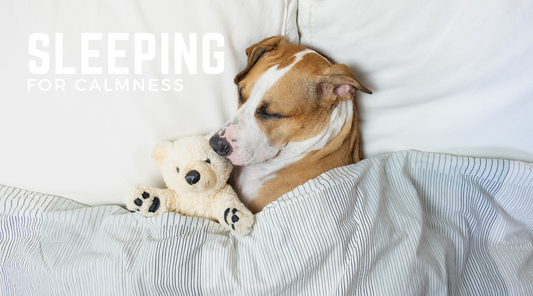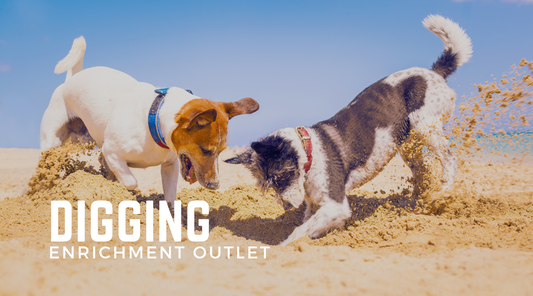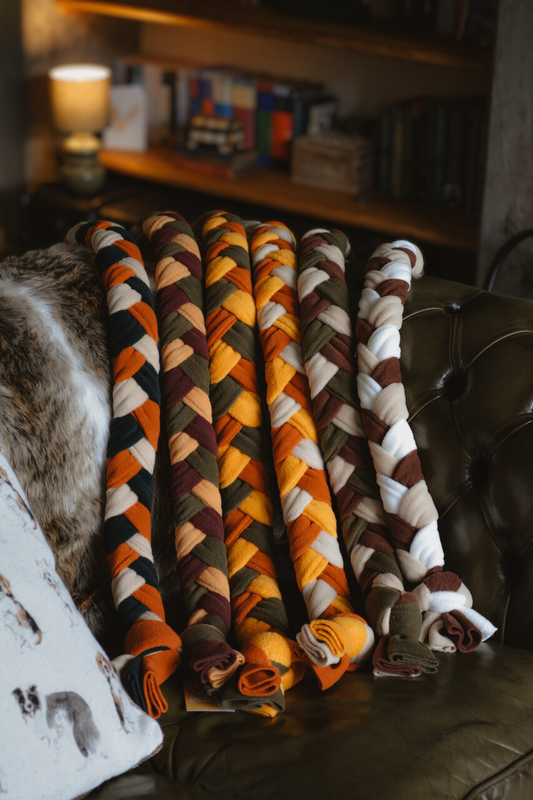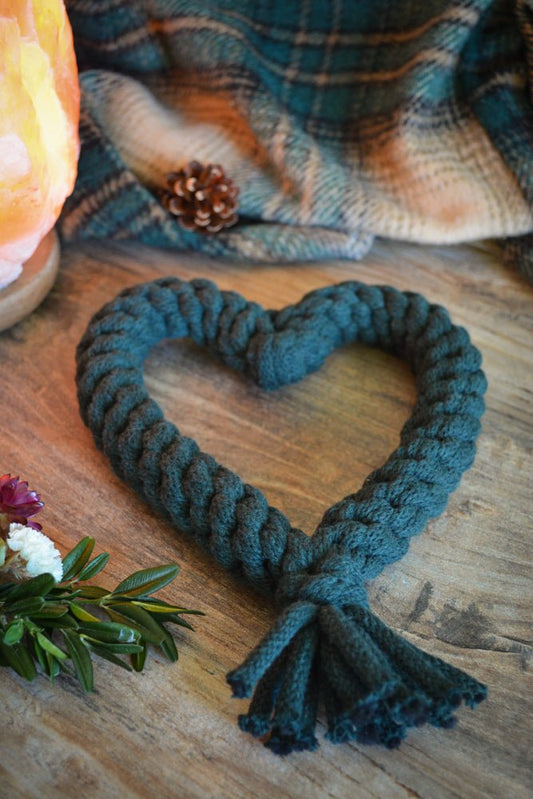
High-Energy Dogs: How To Add Mental Games into Your Daily Routine!
If you're looking for ways to keep your dog mentally stimulated without overhauling your entire day, you've come to the right place 😌
I feel like we're all onboard with walking our dogs. It's a treasured national pastime.
But those of us with high-energy dogs can sometimes get on this proverbial treadmill of walking our dogs longer, further, faster...
Don't get me wrong, I love adventures with Cam, and spending quality time in the countryside is why many of have dogs (that and snuggles).
Some of us even get into running and dog sports such as canicross, which can be great, but you don't have to become an ultra runner to give your dog what they need (she says posing mid-run 😏).

For these high-drive dogs, it's not about more walks (or physical exertion at least) - mental stimulation is the missing puzzle piece. We need to get them using their brain and they don't always do that in the great outdoors.
I know a chap with a pointer who goes out twice a day and sprints laps around the field - the pointer that is, not the chap. That dog is wired! Like a wind up toy, as soon as she's let off the lead... Full throttle. This is a hunting breed, designed to cover ground quickly and efficiently, and boy does she do that.
Energy is output and it needs direction. If we deem a dog to have "excess" energy, it's often because their mental needs are unmet.
...And if our dog has high prey-drive then big countryside romps don't necessarily lead to a calmer dog, which it can be a hard pill to swallow.
I brought home a 'country breed' because I love the countryside and yes, so does a spaniel - they love it so much they want to eat it 😏
The ironic reality is that 'town' walks can be a much calmer, mentally stimulating experience as they have the opportunity for interesting scents - without sweet lambs wandering around to distract.
That's not to say we don't have calm walks in the countryside - we got there by doing calm enrichment in those environments and it has transformed the experience. You can find out more about that here.
But prey-drive is still something to be managed in certain situations and it doesn't have to mean chasing, spaniels are so nose-driven, it can be hard for them to focus on anything else but living life one sniff to the next.
Activating that brain is a safety necessity, and, as a working breed, they should be worked. I'm a lifelong vegetarian so while you won't find me on a beating line, I make sure to do alternative 'seeking' games with him to fulfil that breed trait.
Mentally stimulating your dog can sound overwhelming when you first start looking into it - do I need to join a class, do a PhD in behavioural science?
There are some wonderful activities you can do, such as flyball, agility, scentwork, mantrailing, etc and learning more about behaviour is always helpful, but providing your dog with mental games need to be taxing for you. It's neither complicated nor overly time-consuming, and doesn't require loads of specialist equipment.
I’ve found that the easiest way to make mental games part of everyday life is to anchor it to things I already do - such as walks, mealtimes and in evening time when I'm at chilling at home.
Allocate mental games into your walks 🐾
If you take your dog out twice a day, try allocating 10 minutes of each walk to play a simple mental game. This could be an interactive puzzle toy or DIY version, a few rounds of 'find it' or a mini training session where you work on a specific cue or skill using positive reinforcement and end the session with a short burst of play.
This shift in focus means your dog isn’t just burning off energy - they’re using their brain to make decisions, problem-solve and fulfil natural behaviours.
It’s also worth noting that for some dogs, especially those who are anxious, reactive or easily overaroused, traditional walks can add to their stress load. That doesn’t mean skipping walks altogether, but reconsidering how you use that time can make a big difference to their emotional state.
I have a number of games in the Bond category of the Enrichment Deck that specifically work on boosting confidence and your relationship. This can be a great way to add success to your dog's day - they interact, have fun and get to win rewards.
Mental stimulation is as important as exercise 🧠
For high-energy breeds (like my working-bred spaniel), it can feel tempting to use walks to “tire them out.” Physical exhaustion alone can lead to more excitement and adrenaline rather than true fulfilment. This excitement level has the tendency to trend upwards - so if you have spaniel (or other naturally excitable breed), you may find yourself trapped in a cycle of chaos rather than a cycle of calm!
That’s where mental games for dogs shine. Adding more brain games to your dog's routine can balance out physical energy, helping your dog to feel calmer and more content.
Unlike intense physical activity, mental enrichment doesn’t wear down joints or overstimulate the nervous system. It's also suitable for dogs of all ages so it's an ideal way to connect with your dog throughout their whole life.
Where to add mental games into your dog's day 🕒
Pre or Post Walks
10 minutes of mental games before a walk can help take the edge off any pent-up energy, setting the stage for a calmer, more focused outing.
After a walk, calming enrichment (like those in the Calm category of the Enrichment Deck) can support your dog in winding down from all that outside stimulus.
Just be mindful with food-based activities: avoid giving your dog a meal (or a decent chunk of food) 1.5 hours before or after exercise to reduce the risk of bloat.
Personally, if my dog’s been running around a lot, swimming, or it’s a warm day so he's panting a little, I skip all food and use non-food games or low-energy settling activities.
However, if he’s just had a relaxed mooch, and I can see his body is relaxed, I’ll use a few small treats - a bit of cheese or some leftovers - in a snuffle toy or puzzle.
You don’t need to use much food. A a small, tasty tidbit (especially if it's more novelty, or sometime you dog truly loves, like a few chunks of sausage) works well as a motivator and reward.
Mealtime Anchors
Rather than always using a bowl, turn part of your dog’s meal into a game. Mealtimes are the perfect daily anchor and mental feeding games are a brilliant way to make food more rewarding and provide natural enrichment - dogs are scavengers after all. Try using puzzle toys, homemade foraging boxes or choose a card from my Enrichment Deck for a fresh idea each day.
Lunchtime Reset
If you enjoy a peaceful morning and evening walk, where you can just switch your brain off, then lunchtime could be a great opportunity to squeeze in some mental games, bridging the gap between longer outings and helping prevent boredom.
Say your dog is fed twice a day (breakfast and dinner) and you don't want to add more calories to their dog's day, then simply pinch a bit of food from those meals to use at lunchtime. This can help stabilise energy levels throughout the day.
My spaniel needs a small portion of food right before bed (around 10pm) to get him through the night - otherwise, he is prone to 'empty stomach' which can lead to bile forming. Instead of just giving this to him, it's an opportunity to use a snuffle toy and get in some solid sniffing before bed.
Evening Energy Outlet
Got a dog that gets the “zoomies” in the evening? Mental games are often more helpful than another round of fetch or tug. Brain games give your dog a way to unwind without revving them up further. Independent and long-lasting enrichment activities are perfect for the evening (see Puzzle & Calm categories). These can help create a calmer, restful evening period.
Rest Days & Decompression
After a bigger adventure day, such as our Saturday hikes, we keep Sundays lowkey. I might do one or two mental games using his food, and that’s enough. He spends the rest of the day happily snoozing and snuggling on the sofa. I find it really helpful to have one decompression day during week, for both me and him. He's calmer after a decompression day than he is when out on walks 7 days a week.
How to Make Mental Games Easy & Sustainable
I created the Enrichment Deck to take the guesswork out of daily enrichment.
With 52 activity cards, it’s packed with simple, practical ideas that can be done with things you already have at home. I recommend:
- Keeping the deck somewhere visible, such the kitchen since it's the hub of the house.
- For DIY puzzles, utilise laundry and items destined for the recycling box (egg boxes, cardboard boxes, etc). Another reason why the kitchen is a handy place to centre your enrichment activities since it's likely where you have your dog's food, laundry and recycling.
- Pinning a few cards to the fridge to create a simple weekly plan.
- Start small and make mental games and enrichment part of your feeding routine - even just using ¼ of your dog’s meal.
Allocate 20 minutes to get your head around your own routine and what would work best for you, and then figure out what would make it even easier. Could that mean selecting your card activities for the week ahead? Grabbing a box and having all of your dog's toys, treats and DIY bits in one place? Prepping some long lasting enrichment for the freezer? Plan ahead and set yourself up for success.
Adding mental games into your dog’s daily routine doesn’t mean adding more to your to-do list. It’s about shifting how you do things, not how much.
Start small. Be consistent. Keep it fun.







